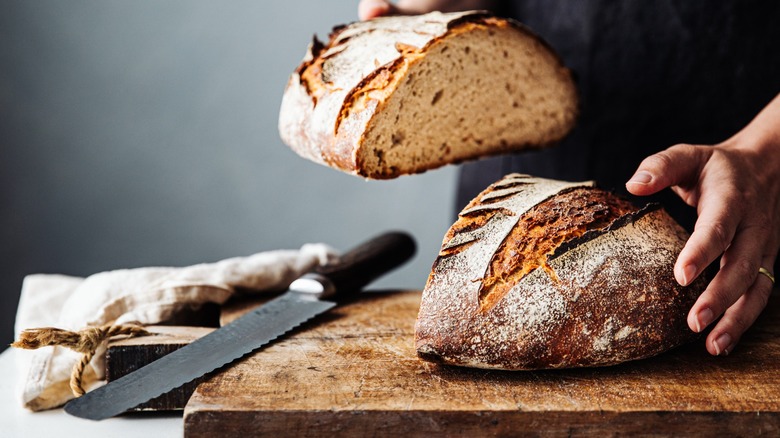The Trick For Giving Sourdough An Extra-Sour Flavor
If you prefer a tangier, more piquant flavor from your homemade sourdough bread, all it takes is some room in your refrigerator and a little patience. You can customize your loaf by allowing it to ferment for longer. That's right, an extended, slow rise is the name of the game because the "sour" in sourdough bread comes from lactic and acetic acids in the sourdough starter – and these take time to form.
The longer the starter and the dough ferment, the more these acids are naturally created by the beneficial live cultures in the starter. Acetic acid (which is found in vinegar) is tangier than lactic acid (which is found in yogurt), and the bacteria that produce it prefer a cooler temperature. The presence of acetic acid is what gives sourdough bread its hallmark strong, tangy flavor. To stimulate acetic acid production, pop that rising dough in the refrigerator for two or three days, giving it a longer proofing time.
During the proofing process, the live yeast and active bacteria culture (Lactobacillus) in your sourdough feeds on the sugar and starches in the dough, releasing the tart acetic acid as a byproduct, which decreases the sweetness and increases the bread's overall tanginess. By contrast, proofing your sourdough loaf at a warmer room temperature will stimulate bacteria that produce lactic acid, resulting in a milder flavor. The fridge, therefore, is the sourness superstar.
Pop your proofing loaf in the fridge for a sour slam
Aside from an extended tenure in the fridge, there are a few other flavorful tips you can utilize to stretch your bread's sourness even further. To really stimulate tart notes, make your bread dough using whole wheat flour. The friendly bacteria love those complex carbohydrates, and they start cranking out acetic acid like mad as they chow down on 'em.
For an ultra-sour finishing touch, stir in ½ teaspoon of citric acid powder along with your salt as you form your bread dough. Also, pre-dough-rolling, try to space out the time between feedings as long as possible for bolder sourness. The more you feed your sourdough starter, the more lactic acid and less acetic acid it produces, resulting in a milder flavor — and, as a general rule, the more starter you use per loaf, the less sour it will be.
Smear your ultra-sour sourdough with salted European butter and orange marmalade for a sweet-salty-tangy breakfast alongside a cuppa joe. Or, use your super-sourdough to make a knockout savory sandwich. The fermented sauerkraut on a Reuben sammy would be showcased beautifully here, but the bold tanginess of the bread could also elevate a classic BLT or mild potato salad sandwich.

